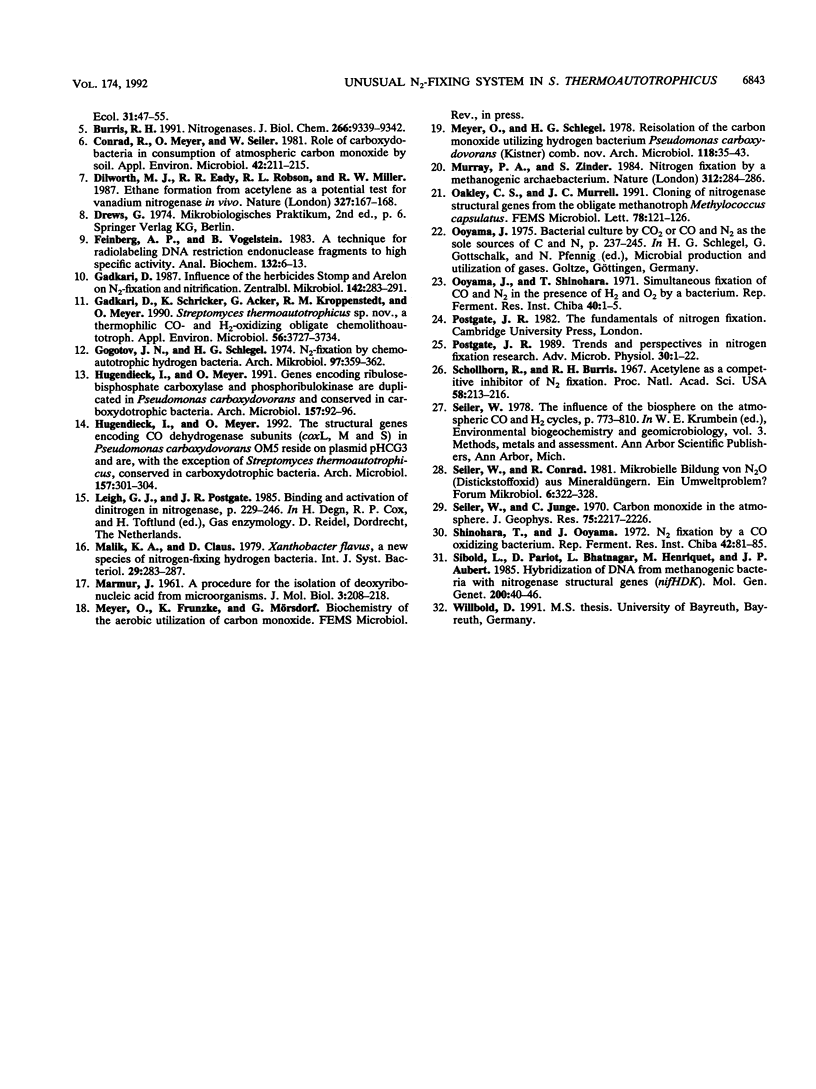Abstract
Streptomyces thermoautotrophicus UBT1, which was isolated previously from a burning charcoal pile, was shown to utilize N2 as a sole nitrogen source when growing chemolithoautotrophically with CO or H2 plus CO2 under aerobic conditions at 65 degrees C. Doubling times under diazotrophic conditions were 10 h. S. thermoautotrophicus is a new CO- or H2-oxidizing, obligately chemolithoautotrophic, thermophilic, free-living, aerobic, N2-fixing streptomycete. Its ability to fix N2 was also evident from (i) the incorporation of substantial amounts of 15N2 (about 13%) into cell material, (ii) the formation of H2 during diazotrophic growth, (iii) the repression of 15N2 assimilation and H2 formation by ammonia, and (iv) culture growth yields with N2 as a nitrogen source that were significantly higher than those without any added nitrogen compounds (ca. 2.4 versus < 0.1 mg [dry weight]). The N2-fixing system of S. thermoautotrophicus exhibited several properties not apparent in the diazotrophic bacteria studied so far, since it was (i) incapable of reducing acetylene to ethylene or ethane and (ii) resistant to inhibition by acetylene or ethylene (5% [vol/vol] each), CO (40 to 70% [vol/vol]), or H2 (40% [vol/vol]). Under stringent conditions, nifH and nifDK gene probes from Klebsiella pneumoniae did not hybridize with total DNA from S. thermoautotrophicus.
Full text
PDF



Selected References
These references are in PubMed. This may not be the complete list of references from this article.
- Arnold W., Rump A., Klipp W., Priefer U. B., Pühler A. Nucleotide sequence of a 24,206-base-pair DNA fragment carrying the entire nitrogen fixation gene cluster of Klebsiella pneumoniae. J Mol Biol. 1988 Oct 5;203(3):715–738. doi: 10.1016/0022-2836(88)90205-7. [DOI] [PubMed] [Google Scholar]
- Ashby G. A., Dilworth M. J., Thorneley R. N. Klebsiella pneumoniae nitrogenase. Inhibition of hydrogen evolution by ethylene and the reduction of ethylene to ethane. Biochem J. 1987 Nov 1;247(3):547–554. doi: 10.1042/bj2470547. [DOI] [PMC free article] [PubMed] [Google Scholar]
- Belay N., Sparling R., Daniels L. Dinitrogen fixation by a thermophilic methanogenic bacterium. Nature. 1984 Nov 15;312(5991):286–288. doi: 10.1038/312286a0. [DOI] [PubMed] [Google Scholar]
- Burris R. H. Nitrogenases. J Biol Chem. 1991 May 25;266(15):9339–9342. [PubMed] [Google Scholar]
- Conrad R., Meyer O., Seiler W. Role of carboxydobacteria in consumption of atmospheric carbon monoxide by soil. Appl Environ Microbiol. 1981 Aug;42(2):211–215. doi: 10.1128/aem.42.2.211-215.1981. [DOI] [PMC free article] [PubMed] [Google Scholar]
- Feinberg A. P., Vogelstein B. A technique for radiolabeling DNA restriction endonuclease fragments to high specific activity. Anal Biochem. 1983 Jul 1;132(1):6–13. doi: 10.1016/0003-2697(83)90418-9. [DOI] [PubMed] [Google Scholar]
- Gadkari D., Schricker K., Acker G., Kroppenstedt R. M., Meyer O. Streptomyces thermoautotrophicus sp. nov., a Thermophilic CO- and H(2)-Oxidizing Obligate Chemolithoautotroph. Appl Environ Microbiol. 1990 Dec;56(12):3727–3734. doi: 10.1128/aem.56.12.3727-3734.1990. [DOI] [PMC free article] [PubMed] [Google Scholar]
- Gogotov J. N., Schlegel H. G. N2-fixation by chemoautotrophic hydrogen bacteria. Arch Microbiol. 1974 May 20;97(4):359–362. doi: 10.1007/BF00403073. [DOI] [PubMed] [Google Scholar]
- Hugendieck I., Meyer O. The structural genes encoding CO dehydrogenase subunits (cox L, M and S) in Pseudomonas carboxydovorans OM5 reside on plasmid pHCG3 and are, with the exception of Streptomyces thermoautotrophicus, conserved in carboxydotrophic bacteria. Arch Microbiol. 1992;157(3):301–304. doi: 10.1007/BF00245166. [DOI] [PubMed] [Google Scholar]
- Meyer O., Schlegel H. G. Reisolation of the carbon monoxide utilizing hydrogen bacterium Pseudomonas carboxydovorans (Kistner) comb. nov. Arch Microbiol. 1978 Jul;118(1):35–43. doi: 10.1007/BF00406071. [DOI] [PubMed] [Google Scholar]
- Oakley C. J., Murrell J. C. Cloning of nitrogenase structural genes from the obligate methanotroph Methylococcus capsulatus (Bath). FEMS Microbiol Lett. 1991 Mar 1;62(2-3):121–125. doi: 10.1016/0378-1097(91)90144-y. [DOI] [PubMed] [Google Scholar]
- Postgate J. Trends and perspectives in nitrogen fixation research. Adv Microb Physiol. 1989;30:1–22. doi: 10.1016/s0065-2911(08)60108-3. [DOI] [PubMed] [Google Scholar]
- Schöllhorn R., Burris R. H. Acetylene as a competitive inhibitor of N-2 fixation. Proc Natl Acad Sci U S A. 1967 Jul;58(1):213–216. doi: 10.1073/pnas.58.1.213. [DOI] [PMC free article] [PubMed] [Google Scholar]


